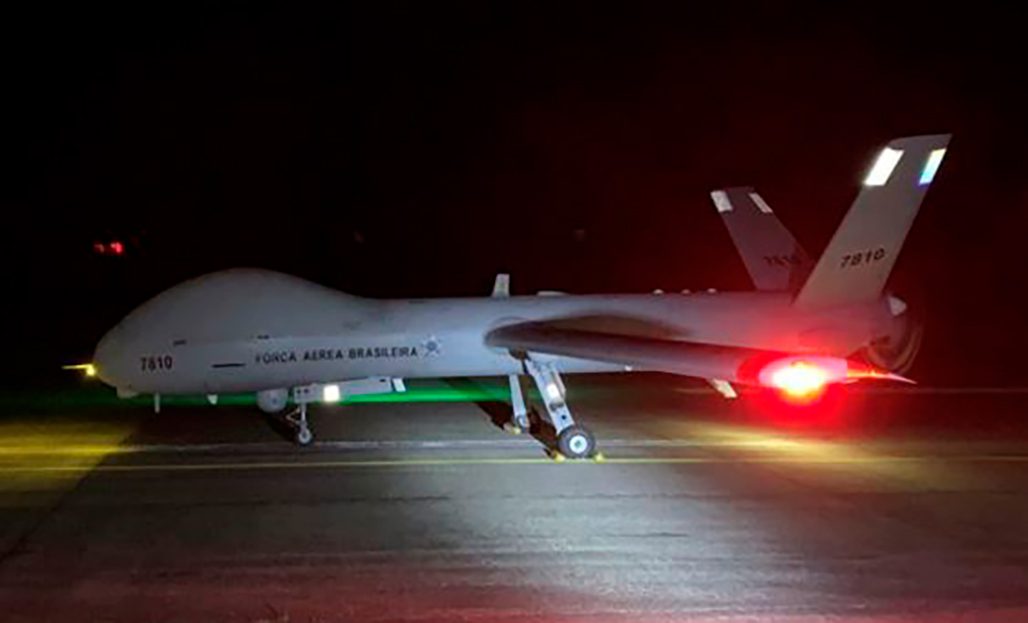The unprecedented mission was carried out by the Horus Squadron (1/12th GAV) and represents an advance in the operationality of the Brazilian Air Force
Agência Força Aérea, by Lieutenant Eniele Santos
The Brazilian Air Force (Força Aérea Brasileira – FAB) conducted, this Friday (09/23), the first transfer flight of a Remotely Piloted Aircraft (RPA), the RQ-900 Hermes, from Santa Maria (RS) to Campo Grande (MS). The distance between the airfields of take-off and landing is approximately one thousand kilometers. Until then, the unmanned missions conducted by the Air Force, although they had great range due to the satellite control, were restricted to takeoff and landing always at the same airfield.
The operation, conducted by the First Squadron of the Twelfth Aviation Group (1/12th GAV – Horus Squadron) and under the aegis of the Aerospace Operations Command (COMAE), was very complex. This is due to the peculiarities of the unmanned system, the susceptibility to weather and the need for multiple coordination between airspace control agencies and crew members, who took turns in the mission being based in Santa Maria (RS), Brasilia (DF) and Campo Grande (MS).
The historic flight took off from the Santa Maria Air Base (BASM), in Rio Grande do Sul (RS), at 3:05 am. A team of maintainers prepared the aircraft and the crew members performed the control with line-of-sight link, i.e., they used a ground antenna pointed directly at the aircraft, which allowed remote control during all phases of the operation.
In the second stage, a crew took control of the RQ-900 from Brasilia (DF), this time by satellite link, performing remote piloting until the Campo Grande (MS) airfield, located more than a thousand kilometers away from Santa Maria (RS).
In the last phase of the operation, before the beginning of the descent procedures for landing in Campo Grande (MS), a local crew took command of the aircraft, in line of sight, making a smooth and safe landing in Campo Grande, the Cidade Morena.
The COMAE Commander, Air Lieutenant Brigadier Heraldo Luiz Rodrigues, highlighted that the flight represented the consolidation of the military Remotely Piloted Aircraft operation in Brazil, started a little over a decade ago, by the Horus Squadron. “The transfer allowed for a reduction in costs and an increase in the RQ-900’s prompt response capacity in the Intelligence, Surveillance and Reconnaissance (IVR) task,” added the General Officer
In this sense, the Commander of the Horus Squadron, Lieutenant-Colonel Aviator Ricardo Starling Cardoso, highlighted, with great pride, the unprecedented feat accomplished. “This flight went down in history as an advance in the operationality of the FAB with regard to the use of unmanned systems. It demonstrated the ability to mobilize and reposition the aircraft to operate from a new deployment base and in a short period of time”, he concluded.

Horus Squadron
The Squadron was created in 2011, at the Santa Maria Air Base, in Rio Grande do Sul, with the objective of operating Remotely Piloted Aircraft (RPA), as the Unmanned Aerial Vehicles (UAV) are also called in the Brazilian Air Force, performing missions of Advanced Air Control, Airborne Post Communications, Combat Search and Rescue (C-SAR) and Aerial Reconnaissance.
The operation of an RPA requires ground systems that allow the control, telemetry and reception of images through a data link system. The aircraft are commanded by aviators with experience in combat aircraft and helicopters, as well as knowledge in military missions and airspace control rules.
In 2014 the Squadron began operating the RQ-900 Hermes aircraft, which have medium altitude and long duration operation capabilities. Equipped with the DCoMPASS electro-optical and thermal sensor, with a high-definition color camera, infrared vision sensor and laser target illuminator and designator, this aircraft also has the SkEye electro-optical system, a set of 10 high-resolution cameras that allows the surveillance of several areas simultaneously, with real-time data transmission. The RQ-900 Hermes flies at over 9,000 meters high and has an autonomy of over 30 hours.

Photos: Horus Squadron *** Translated by the DEFCONPress Team ***
